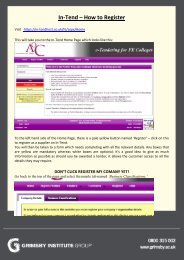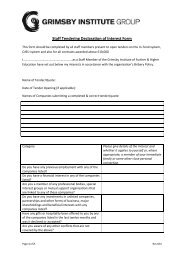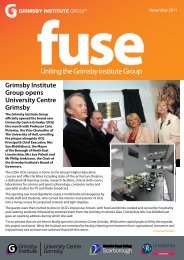Journal of Research & Scholarly Output 2006 - Grimsby Institute of ...
Journal of Research & Scholarly Output 2006 - Grimsby Institute of ...
Journal of Research & Scholarly Output 2006 - Grimsby Institute of ...
Create successful ePaper yourself
Turn your PDF publications into a flip-book with our unique Google optimized e-Paper software.
tongue <strong>of</strong> the learner. The implication for the<br />
discussion above would be that “the wellformedness<br />
or otherwise <strong>of</strong> a learner’s<br />
utterance is not the only criterion for<br />
establishing the presence <strong>of</strong> errors”, and<br />
“what is crucial is whether the normal target<br />
language interpretation <strong>of</strong> his utterance is<br />
appropriate or not in the context” (Corder:<br />
44). For the interpretation <strong>of</strong> the learner’s<br />
idiosyncratic dialect, a teacher is in a good<br />
position to perform the task when he or she<br />
has the following advantages: 1) he or she<br />
has a good understanding <strong>of</strong> the learning<br />
situation <strong>of</strong> the students and can easily<br />
relate the learners’ utterances or sentences<br />
to the actual context 2) he or she is the<br />
native speaker <strong>of</strong> the learner’s mother<br />
tongue and is therefore capable <strong>of</strong><br />
interpreting the learners’ intended meaning<br />
in terms <strong>of</strong> the mother tongue 3) he or she<br />
was once, and may still be the speaker <strong>of</strong><br />
the idiosyncratic dialect, namely, he has the<br />
similar experiences <strong>of</strong> formulating<br />
hypotheses about the rules <strong>of</strong> the target<br />
language. So a teacher who is non-native<br />
speaker <strong>of</strong> the target language but shares<br />
the mother tongue <strong>of</strong> the learners is in a<br />
better position than the native speaker <strong>of</strong><br />
the target language when tracing the errors<br />
in the learner’s interlanguage.<br />
Problems with EA<br />
There still exist a lot <strong>of</strong> problems with the<br />
description <strong>of</strong> the learner’s errors. The<br />
elusive nature <strong>of</strong> the learner’s language, the<br />
variations <strong>of</strong> errors, and the mother tongue<br />
influence all complicate the description.<br />
Following are the major problems:<br />
a. Interlanguage is changing<br />
As the learning process is the process <strong>of</strong><br />
formulating hypotheses about the rules <strong>of</strong><br />
the target language, the learner would<br />
constantly test his or her hypotheses and try<br />
to revise them to be more in accordance<br />
with the target language. So in the strict<br />
sense, it is quite impossible to have a<br />
sectional or horizontal study <strong>of</strong> the learner’s<br />
language. While a longitudinal study is more<br />
feasible, arbitrary decisions have to be<br />
made sometimes as to when some features<br />
disappear and new features arise on the<br />
continuum. Even for well-formed and<br />
appropriate sentences by the learners we<br />
still have a right to doubt that they genuinely<br />
represent the underlying knowledge <strong>of</strong> the<br />
learners, as such utterances or sentences<br />
might be simply an imitation <strong>of</strong> the readymade<br />
set expression or formula. Corder<br />
gave the example <strong>of</strong> the learner’s use <strong>of</strong> the<br />
greeting “how do you do”, <strong>of</strong> which the wellformedness<br />
and appropriateness does not<br />
guarantee that the learner has really<br />
mastered the use <strong>of</strong> the verb ‘do’. However,<br />
the changeable nature <strong>of</strong> interlanguage<br />
does not affect interlanguage as a<br />
systematic and independent language in its<br />
own right. As Corder argued, “that his<br />
language is changing all the time, that his<br />
rules are constantly undergoing revision is <strong>of</strong><br />
course, true and rarely complicates the<br />
problem <strong>of</strong> description but does not<br />
invalidate the concept <strong>of</strong> “ a learner’s<br />
language” (Corder: 56).<br />
b. Only textual data is not enough<br />
Corder has identified two basic constraints,<br />
external constraint and internal constraint,<br />
FOCUS Page Page 91

















